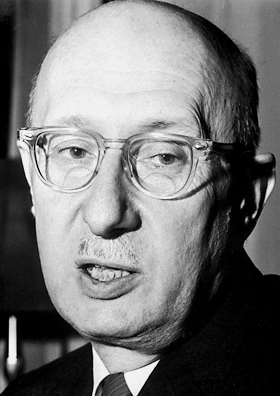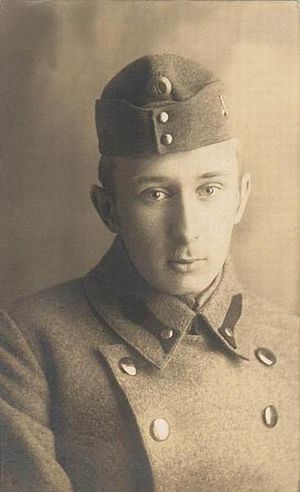Georg von Békésy facts for kids
Quick facts for kids
Georg von Békésy
|
|
|---|---|

Békésy in 1961
|
|
| Born |
György Békésy
3 June 1899 |
| Died | 13 June 1972 (aged 73) |
| Citizenship |
|
| Education | University of Bern |
| Known for | Cochlea |
| Parents |
|
| Awards | Nobel Prize in Physiology or Medicine (1961) ASA Gold Medal (1961) |
| Scientific career | |
| Fields | Biophysics |
Georg von Békésy (born György Békésy) was a Hungarian-American scientist. He studied how we hear. He was born on June 3, 1899, and passed away on June 13, 1972.
Békésy used special tools to watch how a part of the ear, called the basilar membrane, moves when sounds hit it. He found that this membrane moves like a surface wave. Different sounds make different parts of the membrane vibrate the most. High-pitched sounds vibrate the base of the cochlea (a snail-shaped part of the inner ear). Low-pitched sounds vibrate the tip.
He discovered that these vibrations send signals to different nerve fibers. These nerves then carry the sound information from the cochlea to the brain. In 1961, he won the Nobel Prize in Physiology or Medicine for his important research on how the cochlea helps mammals hear.
Georg von Békésy's Life Story
Georg von Békésy was born in Budapest, Hungary, on June 3, 1899. He was the first of three children. His father, Sándor Békésy, was a diplomat. His mother was Paula Mazaly.
Békésy went to school in Budapest, Munich, and Zürich. He studied chemistry in Bern. In 1926, he earned his PhD in physics from the University of Budapest. His research was about quickly finding the weight of molecules.
After his studies, he worked for an engineering company for a year. In 1928, he published his first scientific paper. It was about how the inner ear vibrates. He was offered a job at Uppsala University in Sweden, but he turned it down because of the cold winters.
Before and during World War II, Békésy worked for the Hungarian Post Office. This was from 1923 to 1946. He researched how to improve telephone signals. This work made him very interested in how the human ear works. In 1946, he left Hungary to continue his ear research in Sweden. He worked at the Karolinska Institute.
In 1947, Békésy moved to the United States. He worked at Harvard University until 1966. In 1962, he became a member of the German Academy of Sciences Leopoldina. In 1965, his lab was destroyed by fire. He was then invited to lead a research lab in Honolulu, Hawaii. He became a professor at the University of Hawaii in 1966. He passed away in Honolulu.
Békésy also became an expert in Asian art. He had a large collection of art. He later gave this collection to the Nobel Foundation in Sweden. His brother, Dr. Miklós Békésy, stayed in Hungary. He became a famous scientist who studied plants and farming.
How We Hear: Békésy's Discoveries
Békésy's most important work helped us understand how our inner ear registers different sound frequencies. He found a way to study the inner ear while keeping the cochlea mostly intact.
He used special techniques like strobe photography. He also used tiny silver flakes as markers. This allowed him to see that the basilar membrane moves like a surface wave when sound hits it.
The cochlea and basilar membrane have a special structure. This means that different frequencies of sound cause the biggest vibrations in different places along the basilar membrane. High-pitched sounds make the base of the cochlea vibrate more. Low-pitched sounds make the tip vibrate more.
Békésy realized that this meant different sound frequencies excite different nerve fibers. These nerves then carry the sound messages from the cochlea to the brain. He believed that each sensory cell, called a hair cell, responds best to a specific sound frequency. This idea is called tonotopy. Later, Békésy built a mechanical model of the cochlea. This model showed that the basilar membrane does indeed separate sound frequencies.
Awards and Honors
Georg von Békésy received many awards for his scientific work.
- He won the Nobel Prize in Physiology or Medicine in 1961.
- He also received the ASA Gold Medal in 1961.
- Other honors include the Denker Prize in Otology (1931) and the Leibniz Medal (1937).
- He was given honorary doctorates from several universities around the world.
See also
 In Spanish: Georg von Békésy para niños
In Spanish: Georg von Békésy para niños


